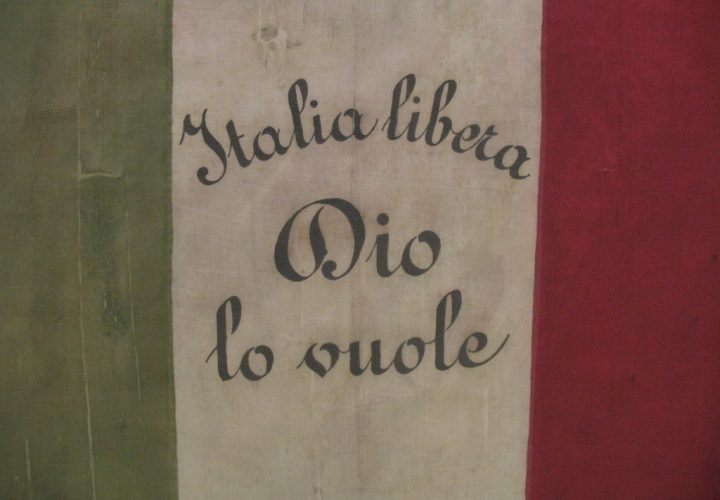Tricolour Flag of the Museum of the Risorgimento in Lucca
After being lowered at the Congress of Vienna which claimed to eliminate the entire Napoleonic period from history, the green, white and red flag introduced in the three years of the Jacobin republics (1796 – 1799) was kept in hiding by secret societies, generally inspired by free masonry.
At this stage in our nation’s history, in all likelihood, the tricolour reappears, among the oldest in Italy and kept at the Museum of the Risorgimento in Lucca: the three vertical stripes in colours that would then have become legitimate place it between the 1820s and beginning of the 1830s, when the colours blue, red and black of the masonic tradition were increasingly replaced by green, white and red. This structure is found, for example, in the flag of the short-lived State of the United Provinces (5 February – 26 April), created from the unsuccessful movements from Emilia and Romagna of 1831; moreover, in July of the same year, the founding constitution of Young Italy, drafted by Giuseppe Mazzini, confirmed that these should be the colours of the Italian flag.
In both cases there are two propositions:
- one historical, or a memory of the tricolour which flew in Emilia and in the Cisalpine Republic;
- the other linked to current politics: the events in France in 1830, which saw the July revolution, the expulsion of the reactionary Charles X and the advent to the constitutional monarchy of Louis Philippe of Orleans, meant the return of another tricolour, that of France, and its extraordinary capacity to evoke the immortal principles of liberty, equality, fraternity.
Once again forced into hiding, the Italian tricolour made an appearance on the eve of 1848, the “year of portents”. After being removed from sight and from Italian emotions for more than 15 years, it flew once more in Lucca from 6 to 10 September 1847 as part of the mass demonstrations which forced Carlo Lodovico of Bourbon, who would abandon the city just a month later, to establish the National Guard, free political prisoners and reinstate laws and reforms. Only a few days later, the green, white and red flag headed the patriotic demonstrations in Livorno and Florence.
A little later came the words on the central white stripe:
“A free Italy is God’s will”
This was a decisive affirmation which took up the governing idea of an Italy based on a confederation with the papacy at its head, which would be distinguished by the tricolours of the provisional Central Government of Lombardy (8 April 1848 – 2 August 1848) and also found on the coinage of the time. Evidence of the extent to which Lucca’s flag was part of the greatest moments of the First War of Independence and all the events of the Risorgimento.
This important tricolour was given to the Museum of the Risorgimento in 1925 by the Administrative Authority of the Province of Lucca, to which it had been donated by Senator Giuseppe Soma in 1895 together with the following letter.
Lucca 2 August 1895
Dear Mr President
of the Authority of the Province of Lucca
I am pleased to donate to this noble Province, where I have passed the last years of my life with great pleasure, the 1821 flag of the Carbonari, to which my father belonged; he had it in his possession and left it to me on his death.
This flag flew during the Five Days of Milan where I fought on the barricades in 1848.
I regret that I do not have the documents proving the authenticity of this flag as they were taken from me at the time of my arrest, as political settlement.
I am sure that the Province of Lucca will jealously guard this historic souvenir of the Revolutionary Movements that paved the way for our national unification.”
signed Giuseppe Soma
(The text of the letter is taken from the booklet “Museum of the war” published by the Province of Lucca Combatants’ Federation, page. 10 – printed by A.M. Amadei – 1934).





